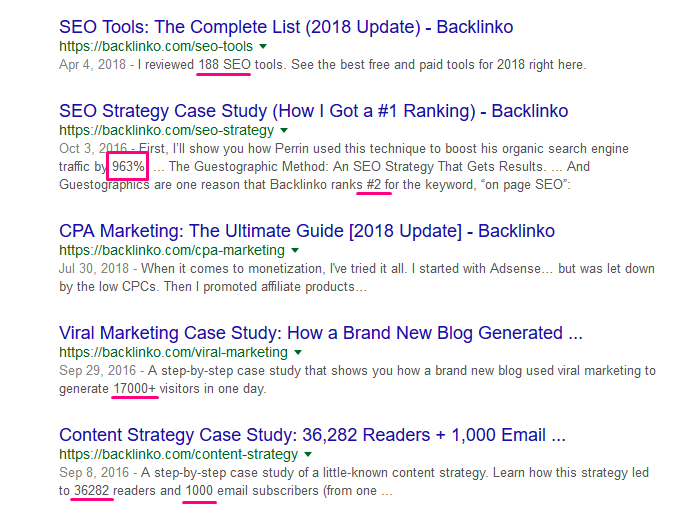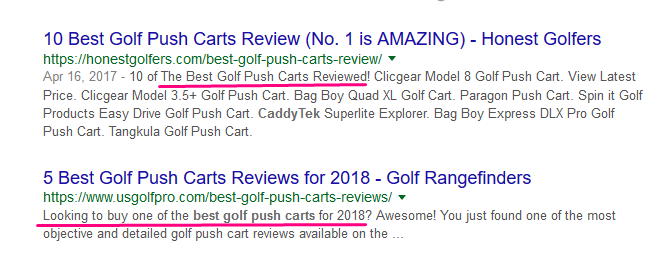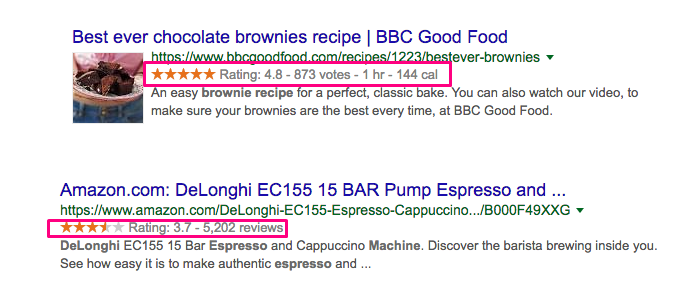What is a meta description?

This is.
Meta description basically is the summary of the whole content of any webpage that we write to preview what the visitor will get on the page if they reach there on following the search engine result.
Thus meta description is a really important factor to get someone to click your website among the other search results. This is your chance to convince people that by clicking your site, they’ll get what they’re looking for.
If they’re convinced by your words in the meta description and your title, that this page has what they’re looking for, they’ll click your website which increases your CTR (Click Through Rate).
Now, as per search engines, meta description has no direct connection with SEO, but their effect on CTR makes them an important indirect ranking factor.
That’s because Google takes CTR as a strong signal of visitor behavior. If they see that you’re ranking 2nd or 3rd, but you’re not getting the amount of click that you’re likely to get, they’ll demote you to lower position.
In similar fashion, a page ranking in the later part of the search page getting more CTR that they’re likely to will rank higher.
That’s how meta descriptions’ effect on CTR makes it a very important indirect factor of ranking.
That said, there’s no scope of not giving meta descriptions the emphasization and attention they deserve while creating one.
If you’re ready to care about the details of creating a meta description, here are the details for you –
Table of Contents
The Do’s for Creating a Convincing Meta Description
Before that, pat yourself on the back that you are at least interested to know how to write a meta description. Why am I saying this?
Do you know, what’s the most important thing about writing meta description? “Writing one.”
Many people are too lazy to write a meta description after writing a long article. So when they skip the meta, the preview in google search result looks awful which is our main goal to avoid.
Writing a meta description is not really rocket science, there are not many secrets. But Kudos to you that you want to write one.
Okay now you’ve congratulated yourself and feeling better, let me reveal those secrets of writing an effective meta description, not much of which are there.
Influence Action, Through an Active Voice
You should tell the visitors right away what specific thing they’ll learn about from that particular webpage, in an active voice obviously.
Try ‘Learn about/Discover the core details to write a killer meta description – Examples included’.
You’re influencing action here right away, asking them to learn something that they themselves want to learn.
Also, this meta description is specifying exactly what you’re going to learn (about meta descriptions), as well as giving you as essence how well the article will explain (examples included) which it is about to explain.
See this example here –

This influences the action of reading the article and buying a push cart, also mention what are the brands that they’ve talked about in the article.
So someone who’s looking for reviews of push carts from these models is very likely to click this result, even if it’s positioned at the bottom part of the search result.
Make Them Curious
You don’t want to put all of your cards on the table right away, but keep something up your sleeves. You want to give an essence to the visitor what is there in the content inside, but not disclose everything right there.
Just a simple question mark or an unfinished sentence can make your customers curious and really want to click on it. See this example:

This is not the example of an ideal meta description, just take the curiosity influencing aspect of it by using a question mark. This one will make someone curious who are looking to learn everything about title tags.
Though this example meta description influences curiosity, it’s not ideal for a meta description because it asks too many questions.
It could rather ask one or two question and then influence an action saying ‘Discover all the secrets about title tags with a 5-minute reading‘ or something like that.
Check another example here, influencing curiosity with the unfinished sentence –

This one asks you a question and the directly dives into answering that.
But the answer remains unfinished. If a visitor likes the beginning of the answer, he/she’ll click the link to find the rest of the answer because of the curiosity that the starting part influenced.
Use Numbers/Facts if Available
This is a killer way to increase the effectiveness of a meta description and have more CTR with the effectiveness. If there’s numbers or facts available, I highly recommend using it. If there’s not a way, find out a way.
People like to see results, people want to hear facts, people like to know exactly what they’re being offered, people want to know exactly how proven a thing is or how effective a trick is.
Compare this two description –
|
Versus, |
|
Which one you’d click?
The second one, right? Because it shows exactly what you’re going to learn and what result it has brought about.
Now you may tell that you don’t have those exact numbers. At least you know that how many points you have in the article. Mention that. As I said, utilize such an opportunity whenever you have.
Also, I encourage writing research-driven articles as they provide better value, and you’ll have numbers this time to showcase.
Neil Patel (a veteran of SEO industry) and Brian Dean (Owner of backlinko, and another veteran of SEO industry) does this best in my eyes. Have a look at these examples…

and,

If the veterans are using this technique for their own blogs, why won’t you?
Be Specific, Don’t Generalise
Try to make things clear to the audience right away. By making things clear, I mean tell them exactly what they’re about to see clicking the page. See this to understand what I’m trying to say –

See, ASOS made things clear exactly what shoe types they have to offer in that web page. They made themselves stand out from the crowd by being specific, which is a good practice that you might want to do as well.
Talk About Your Audience, Not About Yourself
You see, nobody is curious to know how great you think you are. They want to know what’s in it for them, which is your job to tell them.
You’re awesome at something – great! But don’t tell them “I’m great at this, check my site out”. Rather tell them “Satisfy your ‘this’ need with our expertise at ‘this’ thing”.
You see, value proposition to the audience is a key term of marketing, and your meta description is also like marketing, where you’re convincing the audience to come to you over your competitors.
And by saying what’s in there for the audience because of your expertise, you’re proposing value to them.
See how Bistro Burger & Grill did what I’m saying – (though I don’t like the later part of their copy which is kind of bragging)

Use Your Focus Keyword once in The Copy
Using your main/focus keyword in the meta description is a good practice to tell the audience this page is focused on what they’ve searched for. This also helps to make things clear to search engines too.

These two result appeared when I searched for the term ‘best golf push carts’. My intent behind this search is I wanted to find out the best golf push carts and read reviews and expert opinions on them.
So when they wrote ‘10 of The Best Golf Push Carts Reviewed!’ and ‘Looking to buy one of the best golf push carts for 2018?’, they’re clearing me that yes this page is written on best golf push carts, which is exactly what I’m looking for.
And this helps a bit in ranking as well.
These were good examples of how to implement a focus keyword. One blended it into the question and other in the specification. You can follow any of these.
Set up Structured Data
Structured data is not exactly related to writing the copy, but it is responsible for how the meta shows to a visitor. This is what structured data does to a meta description –

The DON’Ts to Create a Great Meta Description
Don’t Deceive Visitors
Don’t promise something in your meta that is not actually present in the content itself. Just to make the meta description attractive, you can’t fake value proposition.
When a visitor will reach your site following that attractive meta but find it’s not actually there what you promised, they’ll hit the back button right away which increases the bounce rate of the site.
It’s such a negative indicator of the user’s experience with a site which Google cares a lot about.
Also, it is not ethical. So don’t do yourself more harm than good following the unethical tactics.
Avoid Keyword Stuffing
Some people tend to overwhelm the meta descriptions with the focus keywords being used multiple times. They think it increases their ranking, which is not the case actually.
Using once is a good practice, but not 3 or 4 times. Neither search engines nor the visitor likes it.
Your primary goal of writing a great meta description is to get searchers to click your website, not increase the ranking.
Don’t Go Too Long
Short and sweet! That’s how you want to do it.
I recommend not going more than 155-160 characters. Google in a recent update, was showing around 300 characters but with another update, they’ve gone back to 150-160 range.
Writing 150 characters when 300 characters were the maximum is still fine. But the people that started to write 300 characters with Google’s update, got issues since Google automatically cuts the finishing portion that exceeds the limit, so this made meta’s to go unfinished.
So it’s better to stay in the safe side and not exceed 150-160 characters.
I know it’s hard to summarize a whole page in this limited characters, but that’s where your creativity has to kick in.
Don’t Duplicate a Meta
I’ve seen people that used the same meta description for all the similar contents in their site which is a very bad practice.
Google can even flag your site for this bad practice.
Give every meta the attention it deserves. It really does not take much time to write 150 characters.
Wrap Up
Those were the Dos and don’ts of writing a great meta description that helps to improve CTR for your site. You can blend your creativity with these tips to make your meta description even better.
If you’ve such creative ideas already, consider sharing them in the comments. Also, shoot any question that you might have.
Good day.

